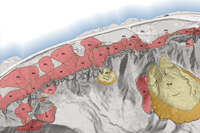Throughout the rainy season, the National Weather Service highlights the potential for debris flows and landslides as part of a flood watch, for areas included in the flood watch.

Debris Flows
Debris flows are rapidly moving, extremely destructive landslides. They can easily travel a mile or more, depending on the terrain. They typically contain boulders and logs transported in a fast-moving soil and water slurry down steep hillsides and through narrow canyons. A debris flow moves faster than a person can run.
Some areas are especially hazardous. People, buildings and roads located below steep slopes in canyons and near the mouths of canyons may be at serious risk. The most dangerous places include:
- Canyon bottoms, stream channels, and areas of rock and soil accumulation at the outlets of canyons.
- Bases of steep hillsides.
- Road cuts or other areas where slopes of hills have been excavated or over-steepened.
- Places where slides or debris flows have occurred in the past.

Stay Safe During Warnings
When you hear there is potential for debris flows and landslides in your area:
-
Stay alert. Track the flood watch by radio, TV, weather radio or online. If told to evacuate, do so immediately.
-
Listen. Unusual sounds might indicate moving debris, such as trees cracking or boulders knocking together. A trickle of falling mud or debris may precede larger landslides. If you think there is danger of a landslide, leave immediately.
-
Watch the water. If water in a stream or creek suddenly turns muddy or the amount of water flowing suddenly decreases or increases, this is a warning that the flow has been affected upstream. You should immediately leave the area because a debris flow may soon be coming downstream.
-
Travel with extreme caution. Assume highways are not safe. Be alert when driving, especially at night. Embankments along roadsides may fail, sending rock and debris onto the road.
-
Stay cautious after the storm. Cleaning up after landslides can also be hazardous. A small mudslide can actually be part of a larger landslide. Cleanup should not be done until after the storm.

Preparing for Landslides
Knowing in advance where danger areas around your home might be is the first step in preparing for landslides. Learn more with: